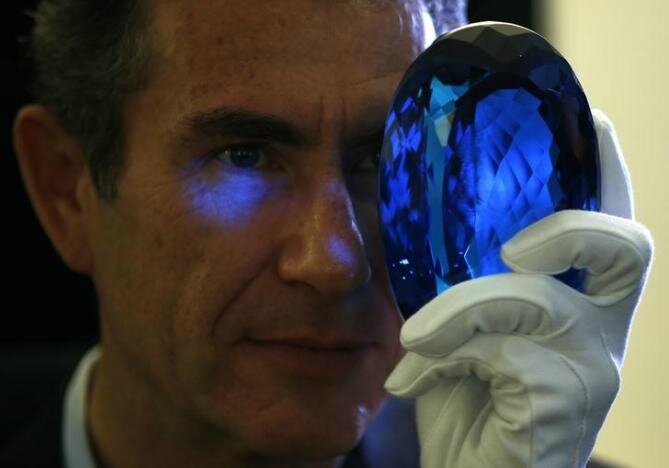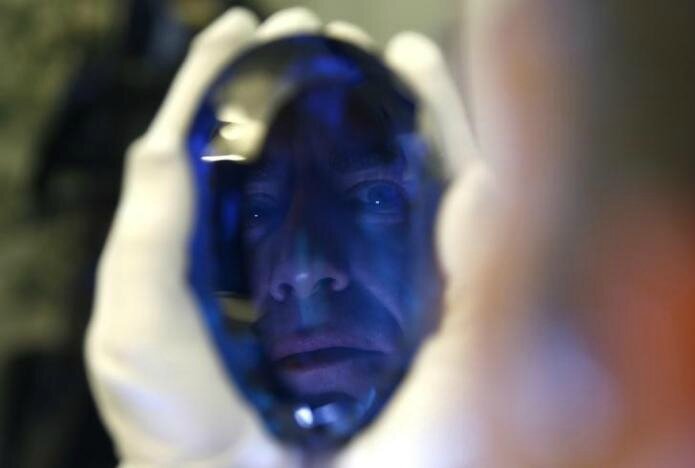Largest known intense blue topaz faceted gemstone goes on display at the Natural History Museum
The Ostro stone. An impressive 9,381 carats blue topaz, around 2 kilograms. © Trustees of the NHM, London.
LONDON.- One of the world’s most colourful and flawless large gemstones, the Ostro stone, has gone on permanent show in the Natural History Museum’s Minerals gallery. The gemstone weighs in at an impressive 9,381 carats - around 2 kilograms, similar in weight to two bags of sugar. It is the first large cut topaz of its kind to go on display at the Museum and will go on show alongside specimens from one of the world’s most important mineral collections.
The Ostro stone is available for the public to view at the Museum through the generosity of philanthropist Maurice Ostro OBE. It has been in the family vaults for three decades since it was discovered in its natural form by his father gemstone pioneer Max Ostro in Minas Gerais, Brazil. It is 15 centimetres in length, 10.5 centimetres wide and its vivid blue colour is exceptional as the various treatment procedures are commonly used for such stones and rarely result in such an intense blue.
Mike Rumsey, Senior Curator of the Minerals Collection at the Natural History Museum says; ‘This stone is an excellent example of how as humans, we have crafted beautiful and desirable objects from the natural mineral specimens we find around us, like those that we preserve in the collections at Museum. It will be on display alongside some of our world leading collection of minerals and gems, which is studied by scientists here to find new sources of minerals, gemstones and metals.’
Ostro Minerals was founded by Max Ostro in 1960. His son Maurice, a well-known entrepreneur and philanthropist, took the helm of the family business 6 years ago when his father died and started to use it to support his various charitable projects.
Maurice Ostro says: “Collecting beautiful coloured gems was my father’s passion; my mission is to leverage his remarkable legacy in a way that would make him proud. We are delighted that the finest of his gemstones will now be part of the collection at the Natural History Museum who share our passion for exceptional stones.”
Sir Michael Dixon, Director of the Natural History Museum says; “We are delighted to be able to display this exquisite blue topaz stone alongside some of nature’s finest mineral examples in this gallery. Our thanks go to Maurice Ostro for the opportunity to showcase this wonderful stone to millions of people".
Philanthropist Maurice Ostro looks through his Ostro stone, the largest known blue topaz stone, for media at the Natural History Museum in London, Britain September 27, 2016. REUTERS/Peter Nicholls.
Philanthropist Maurice Ostro looks through his Ostro stone, the largest known blue topaz stone, for media at the Natural History Museum in London, Britain September 27, 2016. REUTERS/Peter Nicholls.
The Ostro stone, the largest known blue topaz stone, owned by philanthropist Maurice Ostro, is displayed to media at the Natural History Museum in London, Britain September 27, 2016. REUTERS/Peter Nicholls.
Philanthropist Maurice Ostro is reflected in his Ostro stone, the largest known blue topaz stone, as he holds it for media at the Natural History Museum in London, Britain September 27, 2016. REUTERS/Peter Nicholls.
The largest known blue topaz stone, owned by philanthropist Maurice Ostro, is displayed to media at the Natural History Museum in London, Britain September 27, 2016. REUTERS/Peter Nicholls.

/https%3A%2F%2Fprofilepics.canalblog.com%2Fprofilepics%2F1%2F0%2F100183.jpg)
/https%3A%2F%2Fstorage.canalblog.com%2F03%2F02%2F119589%2F96711876_o.jpg)
/https%3A%2F%2Fstorage.canalblog.com%2F11%2F31%2F119589%2F94773502_o.jpg)
/https%3A%2F%2Fstorage.canalblog.com%2F20%2F83%2F119589%2F94772815_o.jpg)
/https%3A%2F%2Fstorage.canalblog.com%2F26%2F72%2F119589%2F75604929_o.jpg)
/https%3A%2F%2Fstorage.canalblog.com%2F59%2F60%2F119589%2F26458628_o.jpg)








/http%3A%2F%2Fstorage.canalblog.com%2F88%2F30%2F119589%2F96581549_o.jpg)
/http%3A%2F%2Fstorage.canalblog.com%2F46%2F63%2F119589%2F95570333_o.jpg)
/http%3A%2F%2Fstorage.canalblog.com%2F65%2F77%2F119589%2F70287225_o.jpg)
/http%3A%2F%2Fstorage.canalblog.com%2F00%2F74%2F119589%2F34152729_o.jpg)